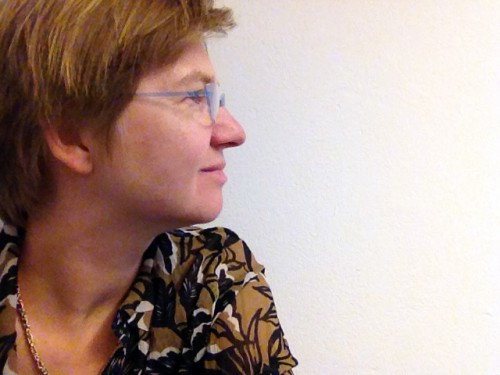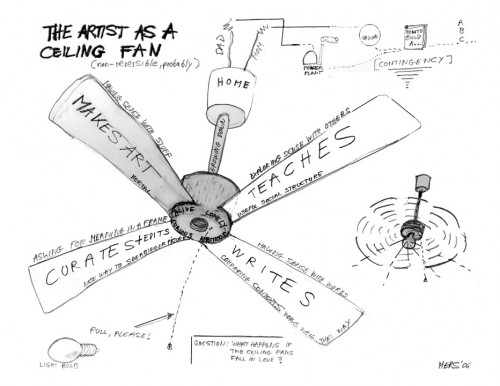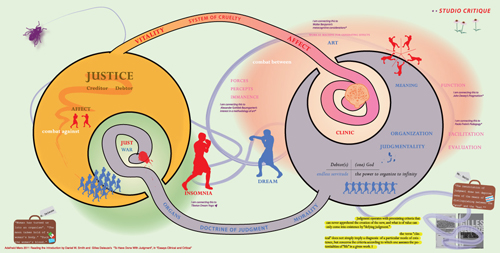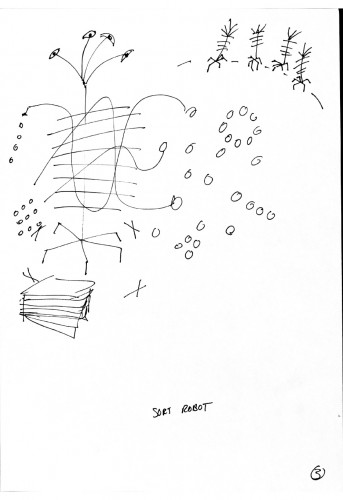Adelheid Mers is a visual artist with a unique, interpretive approach to events and organizations. She creates maps and diagrams as poetic and analytic records of art institutions, exhibitions, public lectures, studio visits, and texts. She has exhibited and lectured widely, curated exhibitions, and received grants from numerous organizations, including the British Council and National Endowment for the Arts. Her teaching experience is expansive, covering curatorial practice, arts administration, arts economies, and grant writing. Mers is an associate professor at the School of the Art Institute of Chicago in the Arts Administration and Policy program. She also is a field editor for Arts Administration and Museum Studies at caa.reviews, published by the College Art Association.
It is an absolute pleasure to present part one of my discussion with Mers.
Georgia Kotretsos: You’re halfway through your sabbatical–what’s your area of study and where about in the world are you?
Adelheid Mers: I am traveling, and also at home, as I interview artists who are working in different areas–visual artists, musicians, composers, performing artists, and artists who curate, write, and administrate, most of the time doing several of the above. I am asking them to speak about their practice, how it evolved, what their central experiences have been. In addition, I have solicited a few scientists and administrators as a control group of sorts. Conversations are brief, free-form, lasting 60-90 minutes. Based on notes taken during a conversation, I then create a diagram from each. At best, these diagrams depict the “engine” that drives the artist’s idiosyncratic practice as presented at that moment. I am looking for patterns in methods and strategies mentioned in those conversations but also for the range of contexts that are being referenced, including texts, popular beliefs, and market structures. Over the last summer, I spent two months in Vienna and at AIR Krems and for some of that time I was able to use the Gallery of the Vereinigung Bildender Künstlerinnen Österreichs Gallery to invite interview partners. I loved the opportunity to host a venue while being a guest in the city.
This week, I am in Vienna again, where I was able to meet with those I talked to over the summer, show them the diagrams I made, and get feedback on my interpretations. I also conducted two more interviews, one with a musician who is currently pursuing a doctorate in art, and another with an actress who has a PhD in Philosophy.
The main reason I am in Vienna now was to participate in a conference, Wissenskulturen Im Dialog – Versuchsanordnungen, organized by Doris Ingrisch at the Institut für Kulturmanagement und Kulturwissenschaft, housed at the University of Music and Performing Arts, Vienna. At the conference my task was to listen and take notes on day one, diagram the proceedings overnight, and present a diagram, a conference matrix, on day two. I’ve been exploring a three line matrix pattern for a while now, a coordinate system that I tag with the outlying terms of the three most prevalent themes of an event. I mark in the fields that open in between how they are negotiated. As I described my take on the conference, attendants received a simple photocopy, formed ad hoc breakout groups, and then returned the annotated copies to me. In a next step, I will integrate remarks into a follow-up diagram. I’ve mapped conferences previously, always with the intent to create both a snapshot of the past and a tool for ongoing conversations, but I am thrilled to have the process integrated into the proceedings here for the first time.
After looking at individual artistic practices and at the complex, discursive platforms of conferences, my third focus is to assess the pedagogic practice of studio critique, particularly from artists’ perspectives. The artist interviews I am leading come straight out of critique as it is conducted at US art schools, inspired by some of the very good experiences that ensued for all participants when critique is conducted carefully, openly, respectfully, and curiously. As this is not the only possible experience, my colleague Judith Leemann and I saw a necessity to compare notes and look at the elements of critique. A multitude of perspectives exists indeed, a few already highly reflected, others conducted intuitively. A guide or handbook is not what we envision. We want to begin by broadening the conversation; we’re convening a panel at the College Art Association Conference in New York in February.
Still, in January, I am trying something entirely new. At the Leuphana University in Lüneburg, Germany, economist Sigrid Bekmeier-Feuerhahn invited me to conduct a workshop with her, an experiment to integrate diagram-facilitated discussion into an audience survey. The very first results are expected in a few days.
GK: I read that you have developed a process in which you translate conversations and other texts into diagrammatic representations by making the finished product available for the next iteration of speech. I detect a Broken Telephone dimension to your method: once something is seen, it’s then told, heard, diagrammed, and then passed on to someone else to see, tell, and hear. What are you interested in most–what’s lost or what’s preserved in this process of retelling?
AM: Norretranders’s term “exformation” makes sense to me here. In creating a diagram, I am condensing what happened in a conversation as highly as possible, while still evoking a common context. A user of the diagram who shares that context, or even just part of it, can play that diagram like an instrument. It can better be played jointly, in conversation.
GK: Tell me about your artist diagrams–the process of interviewing, note taking, and then diagramming a creative profile. How did these portraits of artistic practices come to be?
AM: In 2008, I participated in an artist residency about Artistic Research at the Banff Centre. The theme of the residency was self-reflexivity. I initially diagrammed lectures, my understanding of the Art Research discourse, and my own work process. One day Lee-Ann Pahapill suggested I interview David Court. We sat around a table and drew as we talked. It worked so well that I continued with others. The next time, I took notes and went away to draw, returning later to show the artist. I felt I could see more clearly with that intermediate step, allowing metaphors to sink in and images to emerge more strongly. I have continued to use that mode since.
GK: In a recent conversation we had, when I asked what are you planning to do with the diagrams, you replied, “they are not for an exhibition, they are not for a publication, I am just learning.” This is perhaps the best response I have ever gotten from an artist about a project in progress. An inquiring mind, one which you obviously possess, will always search for new “Engines of Knowledge” as you say. Nonetheless, I have to ask the obvious: what is it you’re after?
AM: My most recent interview partners stressed how practicing is central to their work–developing proficiency and perceiving nuances. In that light, “I am just learning” means I am practicing a craft. It’s not about what I don’t know, but about becoming more observant, better at facilitating a dialogue, allowing its shape to emerge.
That’s almost a wrap. Part two to come!










Pingback: Inside the Artist’s Studio | Adelheid Mers (Part 2) | Art21 Blog
Pingback: Week in Review | 02.02.13 | Art21 Blog